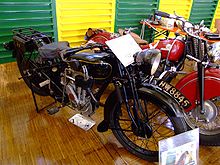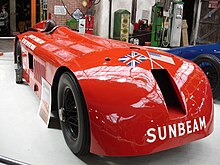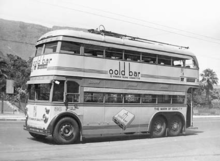Sunbeam
| Sunbeam | |
|---|---|
| legal form | Ltd. |
| founding | 1887 |
| resolution | 1979 |
| Seat | Wolverhampton |
| management | John Marston (founder) |
| Branch | Automotive industry |
Sunbeam (dt. Sunbeam ) was an English brand under which various manufacturers successively marketed bicycles , motorcycles , automobiles , buses , airplanes and aircraft engines . The brand existed until 1982.
Brand history
The company John Matston Ltd was from tableware manufacturers founded John Marston 1887th In March 1905 the operation was converted into a corporation called Sunbeam Motor Car Company Limited with a starting capital of £ 40,000 . After first producing ambulance vehicles , then airplanes and aircraft engines, during the First World War , the company ran into financial difficulties after the end of the war because, on the one hand, business with the engines declined and, on the other hand, payments for war material were outstanding. The auto business was taken over by Talbot and transferred together with Darracq to the STD group . In the 1920s, automobile sales declined, so that Sunbeam turned to the manufacture of chassis for buses and trolleybuses in 1931 with the establishment of Sunbeam Commercial Vehicles , which was only transferred to the corporation Sunbeam Commercial Vehicles Limited in 1934 .
In 1935 the STD Group and Sunbeam Commercial Vehicles Limited were taken over by the Rootes Group , the manufacture of cars in Wolverhampton was given up and this part of the factory was given to Villiers . AEC was interested in bus production for a while , but the joint project of a bus was unsuccessful, so that AEC no longer showed any interest in the company in 1944, so that it was sold in 1946 to the Brockhouse Group, which mainly operates the Wolverhampton plant took over because of the available machine tools . In 1948 the company was renamed Sunbeam Trolleybus Company and sold to Guy Motors in 1949 . Manufacturing in Wolverhampton remained in existence until 1953, when it was relocated to Guy Motors.
motorcycles
Sunbeam motorcycles enjoyed a good reputation for quality. After changing models in the period before the Second World War , one and two-cylinder motorcycles with 500 and 600 cm³ were mainly produced in the post-war period.
Automobiles
history
The beginnings (1901-1919)
In 1899, the former Sunbeam bicycle factory built the first motor car. In 1901, the Moorfield works on Upper Villiers Street in Wolverhampton began series production of a single-cylinder model . From 1903 engines with six and from 1909 engines with two cylinders were built.
The six-cylinder models were always luxuriously equipped cars with large-volume engines. Engines with a displacement of up to seven liters were manufactured for car races. Sunbeam also produced unusually large-volume engines with a displacement of 2.5 to 4.7 liters for the four-cylinder models (for comparison: modern four-cylinder engines rarely have more than 2.2 to 2.4 liters displacement).
| Type | Construction period | Cylinder / valve control | Displacement |
|---|---|---|---|
| Mabley | 1901-1904 | 1 / sv | 326 cc |
| 12 hp | 1903-1905 | 4 / sv | 2413 cc |
| 12 hp | 1904-1910 | 4 / sv | 2660 cc |
| 16/20 hp | 1905-1910 | 4 / sv | 3402 cc |
| 25/30 hp | 1907-1911 | 6 / sv | 5103 cc |
| 20 hp | 1908 | 4 / sv | 4503 cc |
| 35 hp | 1908-1909 | 4 / sv | 6333 cc |
| 16 hp | 1909 | 2 / sv | 3166 cc |
| 14/18 hp | 1909 | 4 / sv | 3402 cc |
| 12/16 hp | 1910-1911 | 4 / sv | 2413 cc |
| 16/20 hp | 1910-1911 | 4 / sv | 3828 cc |
| 25/30 hp | 1901-1904 | 4 / sv | 4676 cc |
| 18/22 hp | 1911-1912 | 6 / sv | 3619 cc |
| 25/30 hp | 1911-1912 | 6 / sv | 7014 cc |
| 12/16 hp | 1912-1914 | 4 / sv | 3012 cc |
| 16/20 hp | 1912-1914 | 4 / sv | 4073 cc |
| 25/30 hp | 1912-1914 | 6 / sv | 6105 cc |
| 16 hp | 1915 | 4 / sv | 3016 cc |
| 20 hp | 1915 | 4 / sv | 4072 cc |
| 30 hp | 1915 | 6 / sv | 6105 cc |
Sunbeam-Talbot-Darracq (1919-1935)
In the course of 1919, Sunbeam merged its automotive activities with the English branch of Darracq and Clement Talbot , which resulted in the Sunbeam Talbot Darracq Group (STD for short) as a merger of British and French automobile manufacturers.
The automobiles sold in Great Britain kept the brand names Sunbeam and Darracq (until 1939). The Talbot brand was preferred for France . They worked together on the construction of racing cars. Production was streamlined under the direction of engineer Louis Coatalen , and Suresnes' models were a resounding success, particularly with the "10cv".
In the 1920s, Sunbeam racing cars set a total of five world records (two of them by Malcolm Campbell ), the last with the Sunbeam 1000 hp . This vehicle was powered by two Sunbeam Matabele aircraft engines with twelve cylinders (water-cooled V12 , DOHC , four-valve, aluminum block), a displacement of 22.4 liters and a maximum output of 500 hp (bhp) at 2000 revolutions per minute. In the middle of the vehicle, where the driver sat, was a three-speed gearbox that drove the rear wheels via chains. With this car Henry Segrave succeeded on March 29, 1927 in Daytona Beach to break the 200 mph limit, in which he reached a speed of 203.792 mph (327.97 km / h ). The 1929 Sunbeam Silver Bullet with 4000 bhp was unsuccessful and led to the cessation of record activities.
| Type | Construction period | Cylinder / valve control | Displacement | power |
|---|---|---|---|---|
| 16/40 hp | 1919-1921 | 4 / sv | 3016 cc | |
| 24 hp | 1919-1921 | 6 / sv | 4524 cc | |
| 16/40 hp | 1921-1924 | 4 / ohv | 3016 cc | 59 kW |
| 14 hp | 1921-1924 | 4 / ohv | 1954 cc | |
| 24/60 hp | 1921-1924 | 6 / ohv | 4524 cc | 46 kW |
| 24/70 hp | 1923-1924 | 6 / ohv | 4524 cc | |
| 12 hp | 1924-1926 | 4 / ohv | 1598 cc | |
| 14/40 hp | 1924-1927 | 4 / ohv | 2120 cc | 30 kW |
| 16/50 hp | 1924 | 6 / ohv | 2540 cc | |
| 20/60 hp | 1924-1927 | 6 / ohv | 3181 cc | |
| 3 liter | 1926-1931 | 6 / dohc | 2916 cc | 68 kW |
| 30/90 hp | 1926-1929 | 8 / ohv | 4826 cc | |
| 16 hp | 1927-1933 | 6 / ohv | 2035 cc | 32 kW |
| 20 hp | 1927-1931 | 6 / ohv | 2916 cc | 40 kW |
| 25 hp | 1927-1933 | 6 / ohv | 3617 cc | 53 kW |
| 35 hp | 1929 | 8 / ohv | 5447 cc | |
| 16 hp | 1931 | 6 / ohv | 2193 cc | |
| 20 hp | 1931-1933 | 6 / ohv | 3317 cc | |
| 20 hp | 1933-1935 | 6 / ohv | 2916 cc | 53 kW |
| 20 hp | 1934-1935 | 6 / ohv | 2194 cc | |
| 25 hp | 1934-1935 | 6 / ohv | 3317 cc | 54.5 kW |
| Dawn | 1934-1935 | 4 / ohv | 1627 cc | 36 kW |
| 20 hp | 1935 | 6 / ohv | 2762 cc | 43 kW |
Rootes Group (1935-1967)
In 1935 STD went bankrupt and was taken over by the Rootes Group , which also included Hillman and Humber . The French part of the company was sold to the Italian entrepreneur Anthony Lago and has been trading as Talbot-Lago since then . While Rootes initially continued the production of British Talbot models, the production of Sunbeam models was discontinued within a few weeks after the takeover of the company. In 1936 Rootes tried to establish the Sunbeam Thirty, a luxury vehicle with Humber technology. The project failed after building four prototypes.
In 1938 Rootes established the Sunbeam-Talbot brand on the British market. The models that were sold as the Sunbeam Talbot were no longer independent. They were mass-produced vehicles that were slightly modified versions of popular Hillman and Humber models.
1953 Rootes gave up the double brand again. Since then the name Sunbeam has been used again. In 1954 the Sunbeam Alpine appeared as a two-seater roadster version of the Sunbeam 90 . In test drives, the Alpine achieved speeds of up to 193 km / h with a displacement of 2.2 liters and 80 hp, while the production models achieved an average of 170 km / h. In 1953 and 1955 Sunbeam Alpines won the Alpine rally, but production of this model was stopped as early as 1955.
In 1963, Sunbeam presented the Venezia model in front of the Doge's Palace in Venice . It was produced in Italy and was based on the Super Minx . The body came from the Italian company Carrozzeria Touring . The special thing about the Venezia was the steel framework mounted on a tubular frame, which was clad with aluminum sheets.
In 1964, Sunbeam presented the Tiger I at the Paris Motor Show , which was sold in Europe as the Alpine 260. The body was taken over from an Alpine, which was built from 1959, the V8 engine was supplied by Ford from the USA. The Tiger I was one of the sportiest models from Sunbeam, with a 4.3 liter displacement reaching 164 hp and a top speed of 192 km / h.
As a sporty everyday car, the Sunbeam Imp GT appeared in 1965 (based on the Hillman Imp , which however only had 42 hp) with a 60 hp four-cylinder engine. The Rootes Imp GT was identical in construction. The Imp GT models were not manufactured on a production line, but in the Rootes racing department. The coupe was called a stiletto.
| Models 1938–1953 (Sunbeam-Talbot) | ||||
|---|---|---|---|---|
| Type | Construction period | Cylinder / valve control | Displacement | power |
| 3 liter | 1938-1940 | 6 / sv | 3181 cc | 60 kW |
| 4 liter | 1938-1940 | 6 / sv | 4086 cc | |
| Ten | 1938-1948 | 4 / sv | 1185 cc | 30 kW |
| 2 liter | 1939-1948 | 4 / sv | 1944 cc | 41 kW |
| 80 Mark I. | 1948-1950 | 4 / ohv | 1185 cc | 34.5 kW |
| 90 Mark I. | 1948-1950 | 4 / ohv | 1944 cc | 47 kW |
| 90 Mark II | 1950-1952 | 4 / ohv | 2267 cc | 51 kW |
| 90 Mark IIA | 1952-1954 | 4 / ohv | 2267 cc | 51-56.5 kW |
| Models 1953-1967 (Sunbeam in the Rootes group) | ||||
|---|---|---|---|---|
| Type | Construction period | Cylinder / valve control | Displacement | power |
| Alpine Mark I. | 1953-1954 | 4 / ohv | 2267 cc | 56.5 kW |
| Alpine Mark III | 1954-1955 | 4 / ohv | 2267 cc | 56.5 kW |
| Mark III | 1954-1957 | 4 / ohv | 2267 cc | 59 kW |
| Rapier i | 1955-1958 | 4 / ohv | 1390 cm³ | 45.5-49.5 kW |
| Mark IIIS | 1957 | 4 / ohv | 2267 cc | 67.5 kW |
| Rapier II | 1958-1959 | 4 / ohv | 1494 cc | 50 kW |
| Alpine I. | 1959-1960 | 4 / ohv | 1494 cc | 57 kW |
| Rapier III | 1959-1961 | 4 / ohv | 1494 cc | 57 kW |
| Alpine II | 1960-1963 | 4 / ohv | 1592 cm³ | 59 kW |
| Rapier IIIA | 1961-1963 | 4 / ohv | 1592 cm³ | 55 kW |
| Alpine III | 1963 | 4 / ohv | 1592 cm³ | 56.5 kW |
| Rapier IV | 1963-1965 | 4 / ohv | 1592 cm³ | 58 kW |
| Alpine IV | 1964-1965 | 4 / ohv | 1592 cm³ | 60 kW |
| Tiger 260 | 1964-1967 | 8 / ohv | 4261 cc | 120.5 kW |
| Imp | 1964-1976 | 4 / ohc | 875 cc | 29-37.5 kW |
| Rapier v | 1965-1967 | 4 / ohv | 1725 cc | 62.5 kW |
| Alpine V | 1965-1968 | 4 / ohv | 1725 cc | 68 kW |
| Tiger 289 | 1967 | 8 / ohv | 4737 cc | 147 kW |
Chrysler Europe (1967-1978)
In 1967 the American company Chrysler took over the majority of the Rootes group. In that year Chrysler merged the British Rootes Group and the companies Simca in France and Barreiros (Spain), also majority owned by Chrysler, to form Chrysler Europe . Initially, all companies continued to build vehicles under the brands they had introduced. The last model of the Chrysler era to bear the brand name Sunbeam was the Coupé Rapier derived from the Rootes Arrow ; In addition, the Humber Scepter of the Arrow generation was sold as the Sunbeam Scepter in some continental European markets . Production of this series ended in 1976. A year later, the name Sunbeam reappeared, this time as a model name. The small car Chrysler Sunbeam , introduced in 1977, was a last-minute stopgap solution, the production of which was necessary in order to receive government aid from the British government.
| Models 1967–1976 (Sunbeam at Chrysler Europe) | ||||
|---|---|---|---|---|
| Type | Construction period | Cylinder / valve control | Displacement | power |
| Alpine V | 1965-1968 | 4 / ohv | 1725 cc | 68 kW |
| Tiger 289 | 1967 | 8 / ohv | 4737 cc | 147 kW |
| Stiletto | 1967-1972 | 4 / ohc | 875 cc | 37.5 kW |
| New rapier | 1967-1976 | 4 / ohv | 1725 cc | 65 kW |
| Rapier H120 | 1968-1976 | 4 / ohv | 1725 cc | 77 kW |
| New Alpine | 1969-1975 | 4 / ohv | 1725 cc | 54 kW |
PPE
After Peugeot bought all rights from Chrysler Europe in 1978, all automobiles previously manufactured by Chrysler Europe were given the name Talbot in 1979 . The sport version of the Talbot Sunbeam was given the name Talbot Sunbeam Lotus in recognition of the development work carried out by Lotus on the basic engine (2172 cm³, 150 hp). The brand name Sunbeam has not been used since 1982.
Omnibuses and trolleybuses
Sunbeam presented the first bus chassis at the end of 1928. It was a 3-axle chassis called Sikh . which was intended for a double-decker bus for 60 to 70 passengers. It was equipped with a 6-cylinder engine with a displacement of 8 liters, which had an output of 142 hp. The design was likely influenced by similar chassis from Guy Motors and Karrier .
In August 1929, the smaller four-axle Phatan chassis was presented, which was suitable for a 26-seater single-decker bus. It was equipped with a six-cylinder engine with a displacement of 6.6 liters and an output of 110 hp.
In 1931, the Sikh chassis is designed for use as a trolley bus - chassis adapted what was an immediate success. It was manufactured in large numbers and Sunbeam became one of the world's leading bus chassis manufacturers.
Military vehicles
During the First World War, Sunbeam built military personnel carriers and a large number of ambulances on the 16-hp chassis . In 1915 the government insisted that the manufacture of these vehicles be transferred to Rover so that Sunbeam could have more capacity for much-needed aircraft engines and planes. Sunbeam did not allow Rover to put its own name on the vehicles, so the Rover plant in Coventry produced vehicles under the Sunbeam name.
Planes
During the First World War built Sunbeam 647 aircraft, including seaplanes Short 827 and Short 310 , Short bombers and Avro 504 - training aircraft .
Aircraft engines
From 1912 to the 1930s, Sunbeam also manufactured engines for aircraft. The engines were marketed under the brand name Sunbeam-Coatalen by chief engineer Louis Coatalen .
literature
- David Culshaw, Peter Horrobin: The Complete Catalog of British Cars 1895-1975. Veloce Publishing plc, Dorchester 1997, ISBN 1-874105-93-6 .
Web links
Individual evidence
- ↑ a b c d e Sunbeam buses. In: www.historywebsite.co.uk. Retrieved November 15, 2015 .
- ↑ Sunbeam vans and lorries. In: www.historywebsite.co.uk. Retrieved November 15, 2015 .
- ^ Graham Robson: The Cars of the Rootes Group , Motor Racing Publications, London 2007, ISBN 978-1903088296 , p. 131.













